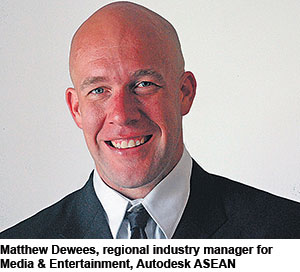Digital artistry in filmmaking
MANILA, Philippines - Whenever I watch a movie I am always amazed at how computer-generated scenes are created to become so lifelike. I guess it explains why many great movies are defined not only by great stories, but rather how a great story is enhanced by digital technology.
This is where Autodesk Inc. media and entertainment staff and software come into play. The software has had a big role in the creation of many of this year’s academy award nominees and was recognized by the Academy of Motion Picture Arts and Sciences with two Scientific and Technical Achievement Awards (Sci-Tech Awards).
“This year has been especially gratifying,” says Chris Bradshaw, Autodesk senior vice president. Not only is it the 19th consecutive year Autodesk software has enabled Academy-nominated filmmakers to push the boundaries of what is possible by enabling them to tell stories that just would not be possible practically – whether it’s creating the weightlessness of outer space or the ice-locked beauty of a frozen world – but Autodesk staff were also recognized by the Academy for two of the technologies they developed, and were instrumental in helping Mark Gill bring The Voorman Problem to the big screen. We are delighted to be such an integral part of innovative filmmaking.”
The Academy honored Autodesk Mudbox, a 3D sculpting software, with an Academy Certificate for its powerful new design capabilities and its contribution to multi-resolution digital sculpting. Additionally, the Academy awarded FiLMBOX, the foundation of Autodesk MotionBuilder, with an Academy Plaque for its innovative architecture that was the basis for the development and evolution of virtual production.
In the Best Visual Effects category, all five film nominees – Gravity, The Hobbit: The Desolation of Smaug, Iron Man 3, The Lone Ranger and Star Trek: Into Darkness — used Autodesk software, to bring their stories to life. Together these five movies contained over 7,000 computer-generated visual effects shots created by thousands of artists working at 42 visual effects studios in 10 countries a testament to the power of technology not only to create what has never been seen before but to bring great talent from around the world together toward a single creative goal.
Autodesk software also played a role in the creation of a number of other movies nominated this year, including Best Animated Features: The Croods, Despicable Me 2, Frozen, and The Wind Rises. Best Animated Shorts: Get a Horse, Mr. Hublot, and Room on a Broom. And eight of the nine movies nominated for Best Picture: 12 Years a Slave, American Hustle, Captain Phillips, Gravity, Her, Nebraska, Philomena, and The Wolf of Wall Street.
We were able to get a few insights from Matthew Dewees, regional industry manager for Media & Entertainment, Autodesk ASEAN, who was in Manila recently.
PHILIPPINE STAR: What is the scope of Autodesk’s business in the media and entertainment segment?
MATTHEW DEWEES: Autodesk is a leader in 3D design, engineering and entertainment software. With 200 million customers around the world, our software is used to design everything from buildings, bridges and cars to consumer products and Academy Award-winning movies.
Autodesk tools create the world’s most compelling media and entertainment, including Academy-award winning films like Gravity and Frozen and Super Bowl commercials and are used to solve the most complex global design, engineering and sustainability challenges. Our portfolio of software and apps empowers organizations of all sizes, creative visionaries, students and consumers to imagine, design and create a better world.
What are the highlights of Autodesk’s new batch of solutions for the media and entertainment market?
More than any technical adjustments or enhancements that Autodesk has integrated in its design solutions for the media and entertainment market, the core or highlight of the new design suite are on the performance, ease-of-use and more innovative tools. You can say that this is our strongest release in many years; the 2015 versions put more creative power back into the hands of the artists. This version pushes the boundaries to allow artists to focus more on their storytelling.
How is Autodesk elevating the visual effects capabilities of local production houses?
Autodesk is continuously providing cutting-edge design tools that will allow local design professionals to create compelling visual effects that may give justice to their concept and storytelling ideas. In the Philippines, there are also outsourcing companies that help develop content for foreign production outfits.
Moreover, there are also some Filipino game developers that are starting to conquer geographic boundaries as their games become available outside of the country. Autodesk basically enables local professionals to create amazing content good enough for them to be more competitive not only locally, but also on an international scale. For example, local post-production houses like Optima Digital have been using Autodesk Digital Entertainment Creation software like Flame, Maya, 3ds Max for more than a decade. Today, using Autodesk solutions, Optima is revolutionizing the way television ads and films look and has pioneered the post-production technology in the Philippines. We work very closely with Optima and this involves the sharing of ideas regarding features, functionalities and direction. We believe that for any company to be successful it should strike a balance between cutting-edge tools and creative, competent people.
How does Autodesk stay on top of its game in relation to creating designs that are always current?
Autodesk believes everyone is creative and has an innate desire to express themselves creatively. Through our software we help unlock the innate creativity in everyone, whether it’s with world-class Academy award-winning media and entertainment technology, or beautifully simple tools for consumers.
We understand the fact that the requirements of visual design and workflow continuously evolve. Because of this, we consistently get the feedback of our customers as they see the factors that we can further improve on and the possibilities that we can expand to.
I think the best example of this is when the movie Avatar came out. While we were used to see stunning visual effects before, we were introduced to a whole new level of cinematic exposure. It was so immersive that the movie changed our capability to enjoy the movie from viewing it to experiencing it.
How do you keep current? Is there a formula for this success?
Technology definitely has a great role to play when you talk about making movies that are solely dependent on visualization and imagination. Superhero movies like Iron Man, Man of Steel, Spider-Man or movies like Lord of the Rings, The Hobbit, and Harry Potter are difficult to imagine or visualize without visual effects.
Also if you look at the movies made in the recent past that won VFX awards it has been movies like: Avatar, Lord of the Rings, Life of Pi, Hugo. All of these movies used Autodesk VFX software like Maya and Flame to showcase spectacular works of art — combining special effects and live-action recording. Movies like Avatar were made entirely in stereoscopic 3D.
How does Autodesk empower the media and entertainment companies in the country?
The Philippines has some of the best post-production crews in the region — the people in the local industry are almost world-class. It is crucial to increase multimedia companies in the Philippines to cater to rising demand for creative multimedia content.
We want to enable small and medium businesses to compete, create amazing content good enough for them to be more competitive not only locally, but also on an international scale. We understand their challenges and have solutions like desktop subscription option for accessing Autodesk software. Autodesk Desktop subscription offers pay-as-you-go plans. Customers can choose from monthly, quarterly, and annual options for using Autodesk Design and Creation Suites and select software products.
In the Philippines, Autodesk offers free student licenses to all post-secondary/ secondary/vocational schools. We are proactive in nurturing the next generation of designers and engineers, and we want them to have easy access to professional tools.
- Latest





























